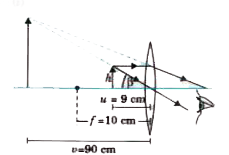A figure divided into squares, each of size 1 mm2, is being viewed at a distance of 9 cm through a magnifying lens of focal length 10 cm, held close to the eye.
(i) Draw a ray diagram showing the formation of the image.
(ii) What is the magnification produced by the lens? How much is the area of each square in the virtual image?
(iii) What is the angular magnification of the lens?
(i) 
(ii) Given, area of each sqaure, A=1mm2
Object distance, u=−9cm
Focal length, f=+10cm
From lens formula,
1v−1u=1f
⇒ 1v=1f+1u=110−19
=9−1090=−190
⇒ v=−90cm
Magnification of image is
m=∣∣vu∣∣=909=10
The area of each square in the image, A.=A×m2
=1mm2×102
=100nm2
(iii) Angular magnification of the lens =D|u|
=259=2.77
Topper's Solved these Questions
- BOOK - MODERN PUBLICATIONCHAPTER - RAY OPTICS AND OPTICAL INSTRUMENTSEXERCISE - PRACTICE PROBLEMS (1)13videos
RAY OPTICS AND OPTICAL INSTRUMENTS
- BOOK - MODERN PUBLICATIONCHAPTER - RAY OPTICS AND OPTICAL INSTRUMENTSEXERCISE - PRACTICE PROBLEMS (2)9videos
RAY OPTICS AND OPTICAL INSTRUMENTS
- BOOK - MODERN PUBLICATIONCHAPTER - NUCLEIEXERCISE - CHAPTER PRACTICE TEST FOR BOARD EXAMINATION15videos
NUCLEI
- BOOK - MODERN PUBLICATIONCHAPTER - SEMICONDUCTOR ELECTRONICS METERIALS DEVICES AND SIMPLE CIRCUITS EXERCISE - CHAPTER PRACTICE TEST FOR BOARD EXAMINATION12videos
SEMICONDUCTOR ELECTRONICS METERIALS DEVICES AND SIMPLE CIRCUITS
Similar Questions
A cardsheet divided into squares each of size 1mm2 is being viewed at a distance of 9cm through a magnifying glass (a conerging lens of focal length 10cm) held close to the eye.
(a) What is the magnification produced by the lenas ? How much is the area of each square to the virtual image ?
(b) What is the angular magnification (magnifying power) of the lens ?
( c) Is the magnification in (a) equal to the magnifying power in (b) ? ExplainView SolutionA card sheet divided into squares each of size 1mm2 is being viewed at a distance of 9 cm through a magnifying glass (a converging lens of focal length 9 cm) held close to the eye.
(a) What is the magnification produced by the lens ? How much is the area of each square in the virtual image ?
(b) What is the angular magnification (magnifying power) of the lens ?
(c) Is the magnification in (a) equal to the magnifying power in (b) ? Explain.View Solution
Knowledge Check
- Question 1 - Select One
A wire mesh consisting of very small squares is viewed at a distance of 8 cm through a magnifying converging lens of focal length 10 cm, kept close to the eye. The magnification produced by the lens is :
A5B8C10D20 - Question 2 - Select One
A wire mesh consisting of very small squares is viewed at a distance of 8 cm through a magnifying converging lens of focal length 10 cm, kept close to the eye. The magnification produced by the lens is :
A5B8C10D20 - Question 3 - Select One
A wire mesh consisting of very small squares is viewed at a distance of 8cm through a magnifying converging lens of focal length 10cm, kept close to the eye. The magnification produced by the lens is:
A5B8C10D20
A graph sheet divided into squares each of size \mm 2 is kept at a distance of 7cm from a magnifying glass of focal length of 8cm. The graph sheet is viewed through the magnifying lens keeping the eye close to the lens. Find (i) the magnification produced by the lens, (ii) the '(irea of each square in the image formed (iii) the magnifying power of the magnifying lens. Why is the magnification found in (i) different from the magnifying power?
View SolutionAn object is placed at a distance of 10 cm from a concave mirror of focal length 20 cm .
(i) Draw a ray diagram for the formation of image.
(ii) Calculate the image distance.
(iii) State two characteristics of the image formed.View SolutionA magnifying lens has a focal length of 10 cm. (a) Where should the object be placed if the image is to be 30 cm from the lens ? (b) What will be the magnification ?
View SolutionA wiere mesth consisting of very small squares is viewed at a distances of 8cm through a magnifying lens of fcoal length 10cm, kept close to the eye. The magnification produced by the lens is
View SolutionA square card of side length 1 mm is being seen through a magnifying lens of focal length 10 cm. The card is placed at a distance of 9 cm from the lens. The appaent area of the card thorugh the lens is
View Solution
